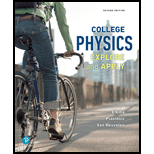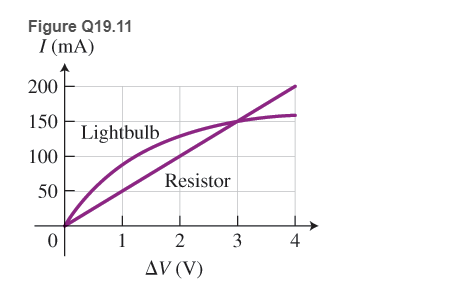
Figure Q19.1 shows

a For
b. For
c. For
d.
e.
f. For any potential difference
g. For any potential difference
h. For potential difference
Want to see the full answer?
Check out a sample textbook solution
Chapter 19 Solutions
EBK COLLEGE PHYSICS
Additional Science Textbook Solutions
Laboratory Experiments in Microbiology (12th Edition) (What's New in Microbiology)
Cosmic Perspective Fundamentals
Microbiology: An Introduction
Human Physiology: An Integrated Approach (8th Edition)
Physics for Scientists and Engineers: A Strategic Approach, Vol. 1 (Chs 1-21) (4th Edition)
Human Anatomy & Physiology (2nd Edition)
- Calculate the magnitude of the gravitational force between 2 protons located 1 meter apart from each other in Newtons using Newton's Law of Universal Gravitation.arrow_forwardIf the metal sphere on the Van de Graff has a charge of 0.14 Coulombs and the person has a mass of 62 kg, how much excess charge would the person need in order to levitate at a distance 25 cm from the center of the charged metal sphere if there is a distance 25 cm from the person to the sphere using Coulomb's Law to calculate the electrical force. Give your answer as the number of Coulombs (with no unit label, as usual).arrow_forwardA balloon is rubbed on a sweater, giving the balloon a negative charge by adding an extra 3.9 x 107 electrons compared to its neutral state. What is the magnitude of the net charge on the balloon, in Coulombs?arrow_forward
- A ping pong ball and a tennis ball are dropped and there is a very small gap between them when the tennis ball hits the floor. Indicate the directions of the momentums of the ping pong ball and the tennis ball after the tennis ball collides with the floor, but before the balls collide with each other. (Drawing a diagram may be helpful.)arrow_forwardDescribe how the momentum of a single ball changes as it free falls from a height of approximately 1 m, collides with a hard floor, and rebounds.arrow_forwardIf the answer is 2.8, -2.8 or -8.4, it is not CORRECTarrow_forward
- Three blocks, light connecting ropes, and a light frictionless pulley comprise a system, as shown in the figure. An external force of magnitude P is applied downward on block A, causing block A to accelerate downward at a constant 2.5 m/s2. The tension in the rope connecting block B and block C is equal to 60 N. (a) What is the magnitude of the force P? (b) What is the mass of block C?arrow_forwardCurrent Attempt in Progress In the figure what is the net electric potential at point P due to the four particles if V = 0 at infinity, q = 2.12 fC, and d = 1.75 cm? d Number MI Units +qarrow_forwardCurrent Attempt in Progress In the figure what is the net electric potential at point P due to the four particles if V = 0 at infinity, q = 2.12 fC, and d = 1.75 cm? d Number MI Units +qarrow_forward
- A 0.500 kg sphere moving with a velocity given by (2.00î – 2.60ĵ + 1.00k) m/s strikes another sphere of mass 1.50 kg moving with an initial velocity of (−1.00î + 2.00ĵ – 3.20k) m/s. (a) The velocity of the 0.500 kg sphere after the collision is (-0.90î + 3.00ĵ − 8.00k) m/s. Find the final velocity of the 1.50 kg sphere. R = m/s Identify the kind of collision (elastic, inelastic, or perfectly inelastic). ○ elastic O inelastic O perfectly inelastic (b) Now assume the velocity of the 0.500 kg sphere after the collision is (-0.250 + 0.850ĵ - 2.15k) m/s. Find the final velocity of the 1.50 kg sphere. ✓ = m/s Identify the kind of collision. O elastic O inelastic O perfectly inelastic (c) Take the velocity of the 0.500 kg sphere after the collision as (−1.00ỉ + 3.40] + ak) m/s. Find the value of a and the velocity of the 1.50 kg sphere after an elastic collision. (Two values of a are possible, a positive value and a negative value. Report each with their corresponding final velocities.) a…arrow_forwardA cannon is rigidly attached to a carriage, which can move along horizontal rails, but is connected to a post by a large spring, initially unstretched and with force constant k = 1.31 x 104 N/m, as in the figure below. The cannon fires a 200-kg projectile at a velocity of 136 m/s directed 45.0° above the horizontal. 45.0° (a) If the mass of the cannon and its carriage is 5000 kg, find the recoil speed of the cannon. m/s (b) Determine the maximum extension of the spring. m (c) Find the maximum force the spring exerts on the carriage. (Enter the magnitude of the force.) Narrow_forwardlaunch angle. Passage Problems Alice (A), Bob (B), and Carrie (C) all start from their dorm and head for the library for an evening study session. Alice takes a straight path,arrow_forward
 Physics for Scientists and EngineersPhysicsISBN:9781337553278Author:Raymond A. Serway, John W. JewettPublisher:Cengage Learning
Physics for Scientists and EngineersPhysicsISBN:9781337553278Author:Raymond A. Serway, John W. JewettPublisher:Cengage Learning Physics for Scientists and Engineers with Modern ...PhysicsISBN:9781337553292Author:Raymond A. Serway, John W. JewettPublisher:Cengage Learning
Physics for Scientists and Engineers with Modern ...PhysicsISBN:9781337553292Author:Raymond A. Serway, John W. JewettPublisher:Cengage Learning
 Principles of Physics: A Calculus-Based TextPhysicsISBN:9781133104261Author:Raymond A. Serway, John W. JewettPublisher:Cengage Learning
Principles of Physics: A Calculus-Based TextPhysicsISBN:9781133104261Author:Raymond A. Serway, John W. JewettPublisher:Cengage Learning College PhysicsPhysicsISBN:9781938168000Author:Paul Peter Urone, Roger HinrichsPublisher:OpenStax College
College PhysicsPhysicsISBN:9781938168000Author:Paul Peter Urone, Roger HinrichsPublisher:OpenStax College Physics for Scientists and Engineers, Technology ...PhysicsISBN:9781305116399Author:Raymond A. Serway, John W. JewettPublisher:Cengage Learning
Physics for Scientists and Engineers, Technology ...PhysicsISBN:9781305116399Author:Raymond A. Serway, John W. JewettPublisher:Cengage Learning





